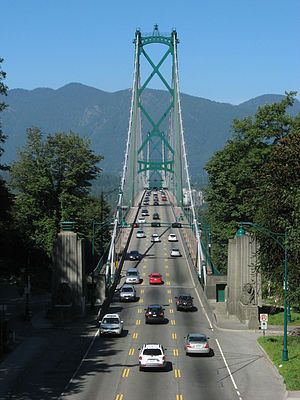Reversible lane
File:Golden Gate Bridge Moveable Median Barrier.webm Reversible lanes are traffic lanes where the direction of flow can be changed according to the traffic demands. This system is used to manage the traffic volume that varies predictably according to the time of day, commonly seen in rush hours in urban areas. The primary goal of reversible lanes is to improve traffic congestion, reduce travel time, and increase the efficiency of the road infrastructure without the need for significant physical expansion.
Operation[edit | edit source]
The operation of reversible lanes involves using traffic signals, signs, and sometimes physical barriers to indicate the current direction of traffic flow within the lane. This system requires careful planning and coordination to ensure the safety of all road users, including drivers, pedestrians, and cyclists. The change in traffic flow is typically scheduled to match peak travel times, such as morning and evening commutes, and can also be adjusted for special events or emergencies.
Types of Reversible Lanes[edit | edit source]
There are several types of reversible lanes, each serving different purposes and found in various settings:
- Contraflow lanes: These are lanes where traffic is allowed to flow in the opposite direction to the rest of the traffic on a roadway, often used during roadworks or in emergency situations.
- High-Occupancy Vehicle (HOV) lanes: During peak hours, these lanes may be reversed to serve the direction with the heaviest traffic flow, promoting carpooling and efficient use of road space.
- Tidal flow lanes: Similar to HOV lanes, tidal flow systems change direction to match the dominant flow of traffic, typically in response to the morning and evening commuting patterns.
Implementation[edit | edit source]
The implementation of reversible lanes requires a comprehensive traffic study to understand the patterns and volumes of traffic. Traffic engineers use this data to design the system, including the placement of signs, signals, and barriers. The success of a reversible lane system also depends on effective communication to the public and the enforcement of traffic rules.
Safety Considerations[edit | edit source]
Safety is a paramount concern in the design and operation of reversible lanes. Measures must be taken to prevent head-on collisions and confusion among road users. This includes clear signage, timely changes in lane directions, and sometimes physical barriers to separate opposing flows of traffic. Emergency access must also be considered in the design of reversible lane systems.
Examples[edit | edit source]
Reversible lanes are used in many cities around the world. Notable examples include the Lincoln Tunnel in New York City, where a lane is reversed to accommodate the heavy commuter traffic entering and leaving Manhattan, and the Golden Gate Bridge in San Francisco, which uses a movable barrier to change the number of lanes available for northbound and southbound traffic.
Challenges[edit | edit source]
The main challenges associated with reversible lanes include the cost of implementation, the need for ongoing management and maintenance, and the potential for driver confusion. Public education campaigns and clear, consistent signage can help mitigate these challenges.
Benefits[edit | edit source]
When properly implemented, reversible lanes can significantly improve traffic flow, reduce congestion, and enhance road safety. They make more efficient use of existing road infrastructure, which can delay or eliminate the need for costly road widening projects.
Search WikiMD
Ad.Tired of being Overweight? Try W8MD's physician weight loss program.
Semaglutide (Ozempic / Wegovy and Tirzepatide (Mounjaro / Zepbound) available.
Advertise on WikiMD
|
WikiMD's Wellness Encyclopedia |
| Let Food Be Thy Medicine Medicine Thy Food - Hippocrates |
Translate this page: - East Asian
中文,
日本,
한국어,
South Asian
हिन्दी,
தமிழ்,
తెలుగు,
Urdu,
ಕನ್ನಡ,
Southeast Asian
Indonesian,
Vietnamese,
Thai,
မြန်မာဘာသာ,
বাংলা
European
español,
Deutsch,
français,
Greek,
português do Brasil,
polski,
română,
русский,
Nederlands,
norsk,
svenska,
suomi,
Italian
Middle Eastern & African
عربى,
Turkish,
Persian,
Hebrew,
Afrikaans,
isiZulu,
Kiswahili,
Other
Bulgarian,
Hungarian,
Czech,
Swedish,
മലയാളം,
मराठी,
ਪੰਜਾਬੀ,
ગુજરાતી,
Portuguese,
Ukrainian
Medical Disclaimer: WikiMD is not a substitute for professional medical advice. The information on WikiMD is provided as an information resource only, may be incorrect, outdated or misleading, and is not to be used or relied on for any diagnostic or treatment purposes. Please consult your health care provider before making any healthcare decisions or for guidance about a specific medical condition. WikiMD expressly disclaims responsibility, and shall have no liability, for any damages, loss, injury, or liability whatsoever suffered as a result of your reliance on the information contained in this site. By visiting this site you agree to the foregoing terms and conditions, which may from time to time be changed or supplemented by WikiMD. If you do not agree to the foregoing terms and conditions, you should not enter or use this site. See full disclaimer.
Credits:Most images are courtesy of Wikimedia commons, and templates Wikipedia, licensed under CC BY SA or similar.
Contributors: Prab R. Tumpati, MD




